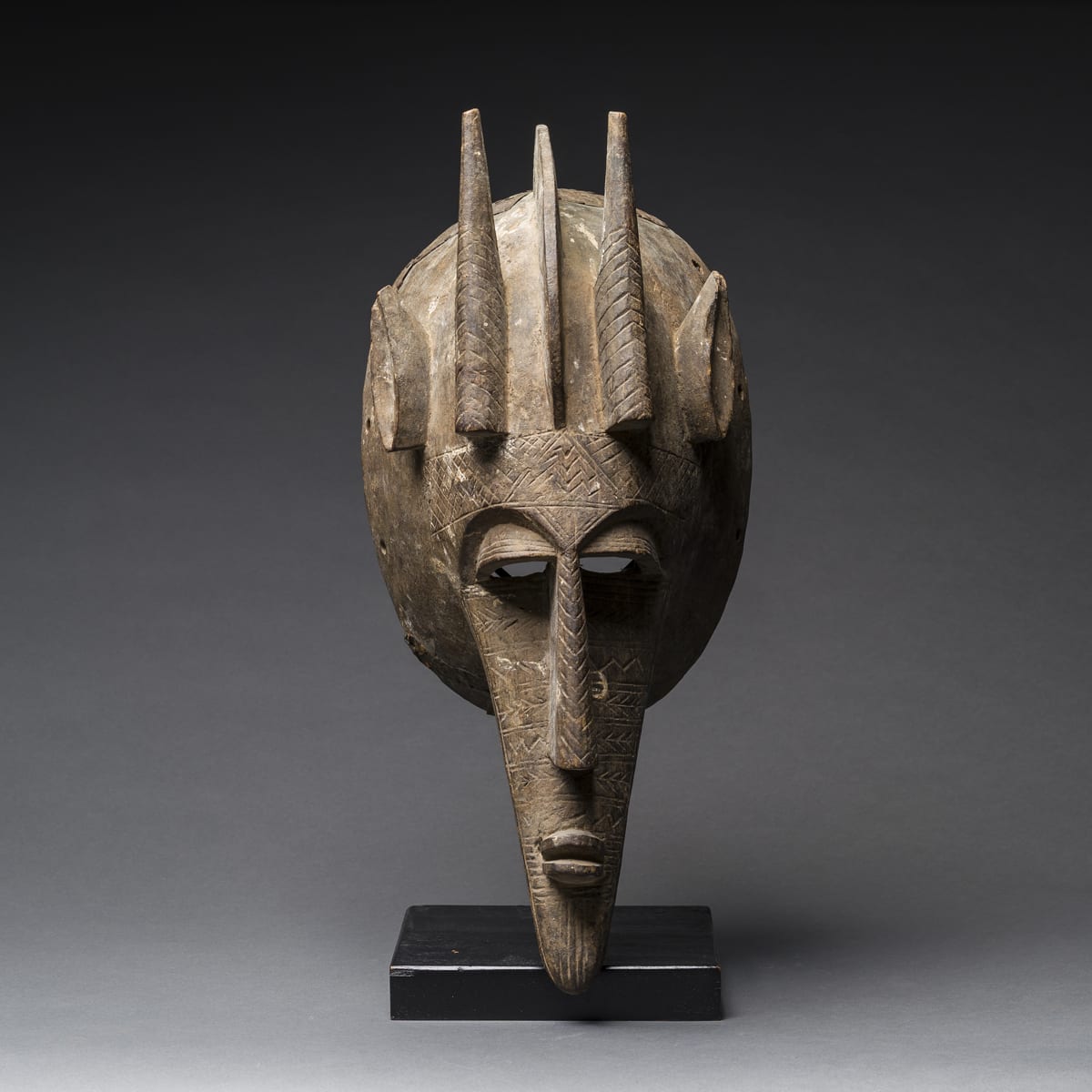Marka ritual wooden Mask, 20th Century CE
Wood, Metal
height 40.6 cm
height 16 in
height 16 in
GDC.044
The Maraka people are a Soninke tribe living in the area of northwest Mali. At the time of the Bambara Empire in Mali (1712-1861), the Maraka were a number of...
The Maraka people are a Soninke tribe living in the area of northwest Mali. At the time of the Bambara Empire in Mali (1712-1861), the Maraka were a number of influential Muslim merchant communities which largely controlled the rich desert-side trade of the nomadic berber tribes who crossed the Sahara. The Bambara Empire integrated Maraka communities into their state structure, and Maraka trading posts and plantations multiplied during the 18th and early 19th centuries. When the pagan Bambara Empire was defeated by the Muslim Toucouleur tribe of Umar Tall in the 1850s, the Maraka's unique commerce, landholdings concessions and prosperity suffered irrevocably.
Today there are only around 25,000 Maraka speakers, and they are largely integrated amongst their Soninke and Bambara neighbours. This mask has a very narrow mouth with raised lips at the bottom of an elongated face. The nose is extremely long and elegantly thin and the eyes are cast downward, a show of respect common in many African masks. The Marakas usually make an extensive use of bronze, copper or tin sheeting affixed to the face of masks with small tacks or brads. The intricate designs on these sheets is reminiscent of the ritual scarification of the Maraka hunters. Where wood is exposed, as in our case, it is often carved in shallow repetitive patterns similar to the patterns on the metal.
The antelope is a form seen repeatedly in Maraka masks as antelopes are revered throughout Mali, being a symbol of the speed and endurance all hunters seek to attain. Some Maraka masks portray human faces, others portray clearly antelope faces, and still others portray a combination of human and antelope features, usually a human face topped by antelope's horns. This mixing of the species in the mask is thought to help the wearer acquire the speed and agility of the antelope. Such masks are used by the Maraka in ceremonies to ensure a successful hunt or a bountiful harvest. The masks are also used in circumcision ceremonies, circumcision being an extremely important turning point in the life of adolescent boys, confirming their worth among peers and legitimizing them as a full member of society.
Today there are only around 25,000 Maraka speakers, and they are largely integrated amongst their Soninke and Bambara neighbours. This mask has a very narrow mouth with raised lips at the bottom of an elongated face. The nose is extremely long and elegantly thin and the eyes are cast downward, a show of respect common in many African masks. The Marakas usually make an extensive use of bronze, copper or tin sheeting affixed to the face of masks with small tacks or brads. The intricate designs on these sheets is reminiscent of the ritual scarification of the Maraka hunters. Where wood is exposed, as in our case, it is often carved in shallow repetitive patterns similar to the patterns on the metal.
The antelope is a form seen repeatedly in Maraka masks as antelopes are revered throughout Mali, being a symbol of the speed and endurance all hunters seek to attain. Some Maraka masks portray human faces, others portray clearly antelope faces, and still others portray a combination of human and antelope features, usually a human face topped by antelope's horns. This mixing of the species in the mask is thought to help the wearer acquire the speed and agility of the antelope. Such masks are used by the Maraka in ceremonies to ensure a successful hunt or a bountiful harvest. The masks are also used in circumcision ceremonies, circumcision being an extremely important turning point in the life of adolescent boys, confirming their worth among peers and legitimizing them as a full member of society.



